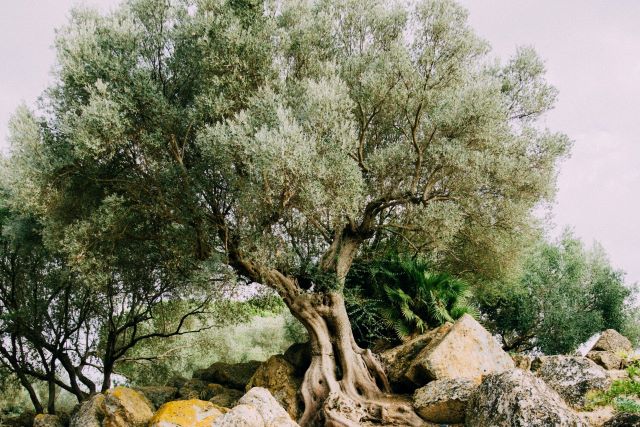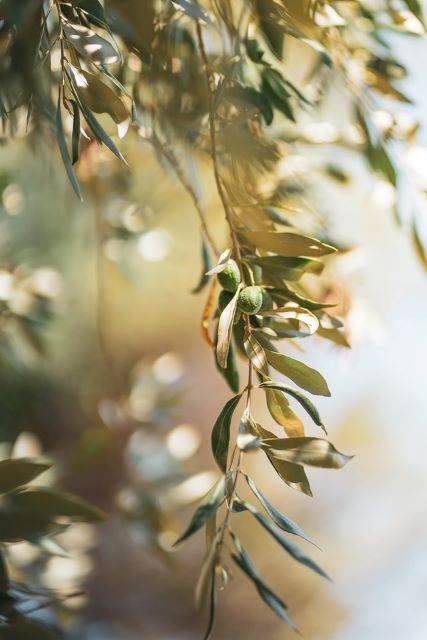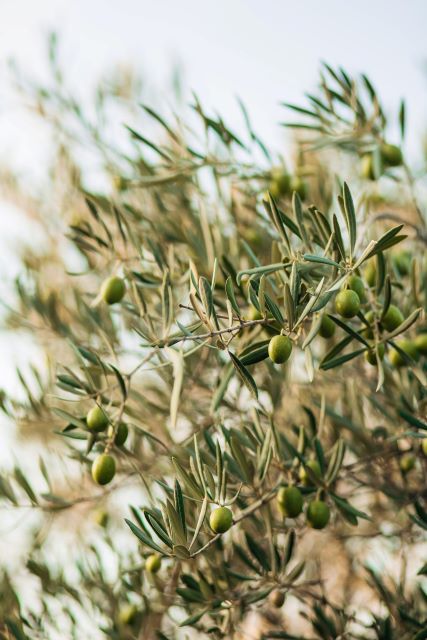Olives are a delicious fruit, and olive oil is a staple in any chef’s kitchen. So it would make sense to want to grow some yourself.
Olive trees are large and sturdy and can live for an average of 500 years. So if your olive tree is dying, you’ll want to know how you can fix it, so it can keep living for a long time.

Luckily, it probably isn’t too late to save your olive tree. In this article, I’ll talk about all of the common problems olive trees face, and what you can do about each of them.
The most common reasons for olive trees dying include watering problems, lack of sunlight, lack of nitrogen, cold temperatures, stress, and natural aging. Diseases and pests can also harm olive trees.
Table of Contents
Underwatered Olive Trees

Olive trees are used to growing in the arid climate of the Mediterranean, and therefore don’t need that much water. However, it’s still possible to give them too little.
Underwatered olive trees will have leaves that wilt, look sunburnt, and then fall off. Luckily, if your olive tree is wilting, a simple watering should have it better in no time.
When young, olive trees need to be watered about once a week, or when the top two inches of soil are dry. Once they’re established, they need even less— sometimes as little as once a month depending on temperatures.
Root Rot in Olive Trees
Conversely, overwatering olive trees can also be a problem. Olive trees don’t need a lot of water to survive, so they are especially susceptible to overwatering.
Since you’re watering your olive trees infrequently, each watering should be deep, meaning you give them a lot of water once a week or less. Giving them less water more often is likely to cause issues.
If you’ve been overwatering your olive tree, the solution is simple: let it dry out a bit before watering again. However, if root rot has set in, it will be much harder to treat.
Root rot is a fungal disease caused by overwatering. It will cause the roots of your olive tree to turn dark and mushy, and eventually kill the tree. If caught early, you may be able to remove the infected roots and dry the rest out. However, there’s not much else that can be done for root rot.
Root rot is more likely in young olive trees, whose roots are younger and not as developed. And keeping olive trees in a loose, well-draining soil will help prevent overwatering as well.
Lack of Sunlight in Olive Trees

Since olive trees hail from the Mediterranean, they’re used to getting a lot of sun. They need full sunlight, meaning at least 8 hours of direct light every day. Less than that and they’ll start to struggle.
The signs of a lack of sunlight include leaves turning yellow, wilting, and then falling off. Additionally, the tree may only grow in one direction — toward where the most light is coming from.
If you have a potted olive tree, it’s easy to fix this — just move the pot somewhere where it can get more light.
For trees in the ground, you can try to remove any nearby objects or trees that may be blocking the light.
Or, you may have to transplant your olive tree somewhere with more sun. Remember to be careful doing this, so you don’t cause stress (more on that later).
Nitrogen Deficiency for Olives
Olive trees need a lot of nitrogen to support their blooming and fruiting, as well as general growth. If they’re not getting enough of this they won’t be able to grow properly.
When olive trees aren’t getting enough nitrogen, their leaves will start to turn yellow, and growth may be stunted. If your olive tree’s leaves are turning yellow and you know it’s getting enough sunlight, it’s likely a nitrogen deficiency.
The only way to know for sure though is to use a soil test kit. This will tell you if you have the right amount of nitrogen in your soil, as well as other important nutrients and the soil pH level.
If the test reveals that your soil needs more nitrogen, a nitrogen-heavy fertilizer is what you need. Blood meal like this one, is a great option that will deliver a lot of nitrogen to your olive tree. Simply follow the instructions on the package and your tree should bounce back soon.
Temperature Too Low for Olive Trees
The ideal temperature range for olive trees is 60-70 °F (15-21 °C) although they can grow in temperatures as high as 100 °F (38 °C) or over. However, they don’t often do well with low temperatures.
Adult olive trees will usually be fine with temperatures as low as 20 °F (-6 °C). Younger trees are more sensitive to cold though, and should be kept closer to that 60 degree (15 °C) mark.
If olive trees get too cold, they’ll start to drop their leaves and stop growing. If you live in a place with cold winters and you have a young olive tree, consider bringing it inside for the winter.
If you can’t bring the tree inside, mulch can sometimes help, as it will keep the soil temperatures higher. And once olive trees are well-established, they’re much sturdier in the face of cold weather.
Transplant Stress Killing Olive Trees
Sometimes you have to transplant your olive tree somewhere else. However, you have to be careful doing this, as it can stress your plant and cause it to start dying.
There are two common types of olive tree transplant stress: root stress and climate differences.
Root problems occur when you disturb the roots of your olive tree when moving it. To help avoid this, dig in a wide circle around the olive tree roots, and leave the core of the roots as intact as possible. Be very gentle when moving your tree.
Climate differences are a problem if you’re moving your olive tree somewhere with a very different climate than where it was before. To help prevent stress when doing this, help acclimate it by slowly changing its conditions for a few weeks before moving this. This can mean changing temperature, light conditions, or whatever else will be different in its new location.
If your olive tree does get transplant stress, the best thing you can do is to keep caring for it the best you can. If it’s well-established, it should be just fine, and many younger olive trees can recover too.
Natural Olive Tree Aging
Olive trees are evergreen, meaning they don’t lose their leaves for winter. However, they are often in the process of shedding leaves to grow new ones.
Typically, when olive leaves reach 2 to 3 years old, they will turn yellow and drop off. This is a perfectly natural process that allows olive trees to grow new leaves.
So if your olive tree is losing some leaves but shows no other signs of poor health, it could just be natural shedding. Keep an eye on it to make sure it doesn’t get worse, but if not, it will be fine.
Olive Tree Diseases
Diseases are a big pain to deal with because they can be very hard or even impossible to treat. When it comes to diseases, the best treatment is prevention. Luckily, olive trees are fairly disease-resistant. There are still two diseases you should look out for.
The first is verticillium wilt. This is a fungal disease that thrives on excessive moisture. It causes the olive leaves to wither, then branches die. It can kill an entire olive tree in a few years.
There is no reliable treatment for verticillium wilt. Avoid excessive moisture to prevent it from taking hold. If it does show up, remove infected branches immediately, and the tree may recover.
The other common disease is olive knot. This is a bacterial disease that often enters through cuts or wounds on the plant. Try to avoid leaving open wounds, and if you do have to cut the olive tree, do it with clean tools.
Olive knot causes galls (or knots) to form on the trunk, which restricts energy production. Eventually, leaves wilt and fall off. If you notice this happening, an organic biofungicde might be able to kill the disease.
Pests on Olive Trees
The first pest you should watch out for is olive fruit flies. These won’t kill your olive tree, but they lay eggs in the fruit, which then hatch and make the olives inedible. You’ll notice this happening because there will be small tan or brown entry holes in the olives.
Yeast traps are great for catching these pests, as they will get attracted to the yeast and then die in it. You can buy yeast traps, or use old beer, apple cider vinegar or something similar.
The other pest is scale. These insects suck the sap out of olive leaves, causing yellow discoloration. They also leave behind trails of sticky residue. They can do a lot of damage to olive trees.
To get rid of them, try a spray of soap and water, or a spray of water and neem oil. Both of these will kill off scale and keep your olive tree healthy.
Further reading:
- Are Olives a Fruit or Vegetable? Answered!
- Why Are My Olives So Small? Causes and Solutions
- Can You Eat Olives Off the Tree? Answered!
- Why Is My Bay Tree Dying? Causes and Solutions
- Why Are My Oranges So Small? Causes and Solutions
- Why Is My Eggplant Dying? Causes and Solutions
- Why Are My Mulberries So Small? Answered!
